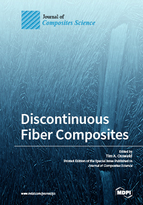Discontinuous Fiber Composites
A special issue of Journal of Composites Science (ISSN 2504-477X). This special issue belongs to the section "Fiber Composites".
Deadline for manuscript submissions: closed (30 June 2018) | Viewed by 68942
Special Issue Editor
Interests: short fiber composites; long fiber composites; fiber orientation, fiber attrition; failure criteria
Special Issues, Collections and Topics in MDPI journals
Special Issue Information
Dear Colleagues,
Discontinuous fiber-reinforced polymers have gained importance in the transportation industries due to their outstanding material properties, lower manufacturing costs and superior lightweight characteristics. One of the most attractive attributes of discontinuous fiber reinforced composites is the ease with which they can be manufactured in large numbers, using injection and compression molding processes.
Typical processes involving discontinuous fiber reinforced thermoplastic composite materials include injection and compression molding processes as well as extrusion. Furthermore, the automotive and appliance industries also use thermosets reinforced with chopped fibers in the form of sheet molding compound and bulk molding compound, for compression and injection-compression molding processes, respectively.
A big disadvantage of discontinuous fiber composites is that the configuration of the reinforcing fibers is significantly changed throughout production process, reflected in the form of fiber attrition, excessive fiber orientation, fiber jamming and fiber matrix separation. This process-induced variation of the microstructural fiber properties within the molded part introduces heterogeneity and anisotropies to the mechanical properties, which can limit the potential of discontinuous fiber reinforced composites for lightweight applications.
The main aim of this Special Issue is to collect various investigations focused on the processing of discontinuous fiber reinforced composites and the effect processing has on fiber orientation, fiber length and fiber density distributions throughout the final part. Papers presenting investigations on the effect fiber configurations have on the mechanical properties of the final composite products and materials are welcome in the Special Issue. Researchers who are modeling and simulating processes involving discontinuous fiber composites as well as those performing experimental studies involving these composites are welcomed to submit papers. Authors are encouraged to present new models, constitutive laws and measuring and monitoring techniques to provide a complete framework on these groundbreaking materials and facilitate their use in different engineering applications.
Prof. Dr. Tim A. Osswald
Guest Editor
Manuscript Submission Information
Manuscripts should be submitted online at www.mdpi.com by registering and logging in to this website. Once you are registered, click here to go to the submission form. Manuscripts can be submitted until the deadline. All submissions that pass pre-check are peer-reviewed. Accepted papers will be published continuously in the journal (as soon as accepted) and will be listed together on the special issue website. Research articles, review articles as well as short communications are invited. For planned papers, a title and short abstract (about 100 words) can be sent to the Editorial Office for announcement on this website.
Submitted manuscripts should not have been published previously, nor be under consideration for publication elsewhere (except conference proceedings papers). All manuscripts are thoroughly refereed through a single-blind peer-review process. A guide for authors and other relevant information for submission of manuscripts is available on the Instructions for Authors page. Journal of Composites Science is an international peer-reviewed open access monthly journal published by MDPI.
Please visit the Instructions for Authors page before submitting a manuscript. The Article Processing Charge (APC) for publication in this open access journal is 1800 CHF (Swiss Francs). Submitted papers should be well formatted and use good English. Authors may use MDPI's English editing service prior to publication or during author revisions.
Keywords
- discontinuous fibers
- chopped fibers
- short fiber reinforced thermoplastics (SFT)
- long fiber reinforced thermoplastics (LFT)
- sheet molding compound (SMC)
- bulk Molding Compound (BMC)
- fiber orientation distributions
- fiber length distributions
- fiber density distributions
- fiber attrition
- micro computed tomography
- compression molding
- injection molding
- compounding






